管理马斯洛--中文英文对照版.pdf
(完整版)罗宾斯《管理学》内容概要,中英文对照

罗宾斯《管理学》内容概要第一篇导论1章管理者和管理1、组织组织(organization)的定义:对完成特定使命的人们的系统性安排组织的层次:操作者(operatives)和管理者(基层、中层、高层)2、管理者和管理管理者(managers)的定义:指挥别人活动的人管理(management)的定义:同别人一起或者通过别人使活动完成得更有效的过程。
管理追求效率(efficiency)和效果(effectiveness)管理职能(management functions):计划(planning)、组织(organizing)、领导(leading)、控制(controlling)管理者角色(management roles):人际关系角色(interpersonal roles)、信息角色(information roles)、决策角色(decision roles)成功的管理者和有效的管理者并不等同,在活动时间上,有效的管理者花费了大量的时间用于沟通,而网络联系(社交等)占据了成功的管理者很大部分时间。
管理者在不同的组织中进行着不同的工作。
组织的国别、组织的类型、组织的规模以及管理者在组织中的不同层次决定了管理者的角色扮演、工作内容以及职能和作用。
2章管理的演进1、20世纪以前的管理:亚当·斯密的劳动分工理论(division of labor)产业革命(industrial revolution)2、多样化时期(20世纪):科学管理(scientific management):弗雷德里克·泰勒一般行政管理理论(general administrative theory):亨利·法约尔(principles of management)、马克斯·韦伯(bureaucracy)人力资源方法(human resources approach):权威的接受观点(acceptance view of authority),霍桑研究,人际关系运动(卡内基、马斯洛),行为科学理论家(behavioral science theorists)定量方法(quantitative approach)3、近年来的趋势(20世纪后期):趋向一体化过程方法(process approach)系统方法(systems approach):封闭系统和开放系统(closed systems)权变方法(contingency approach):一般性的权变变量包括组织规模、任务技术的例常性、环境的不确定性、个人差异4、当前的趋势和问题(21世纪):变化中的管理实践全球化(globalization)工作人员多样化(work force diversity)道德(morality)激励创新(innovations)和变革(changes)全面质量管理(total quality management, TQM):由顾客需要和期望驱动的管理哲学授权(delegation)工作人员的两极化(bi-modal work force)3章组织文化与环境:管理的约束力量1、组织组织文化(organizational culture)被用来指共有的价值体系。
managementglindex(管理学术语表·).docx
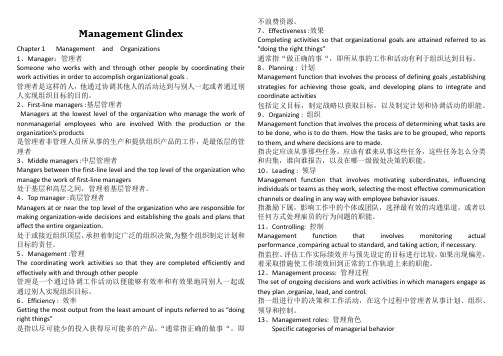
Management GlindexChapter 1 Management and Organizations1、Manager:管理者Someone who works with and through other people by coordinating their work activities in order to accomplish organizational goals .管理者是这样的人,他通过协调其他人的活动达到与别人一起或者通过别人实现组织目标的目的。
2、First-line managers :基层管理者Managers at the lowest level of the organization who manage the work of nonmanagerial employees who are involved With the production or the organization’s products是管理着非管理人员所从事的生产和提供组织产品的工作,是最低层的管理者3、Middle managers :中层管理者Mangers between the first-line level and the top level of the organization who manage the work of first-line managers处于基层和高层之间,管理着基层管理者。
4、Top manager :高层管理者Managers at or near the top level of the organization who are responsible for making organization-wide decisions and establishing the goals and plans that affect the entire organization.处于或接近组织顶层,承担着制定广泛的组织决策,为整个组织制定计划和目标的责任。
马斯洛需求层次理论英语作文素材
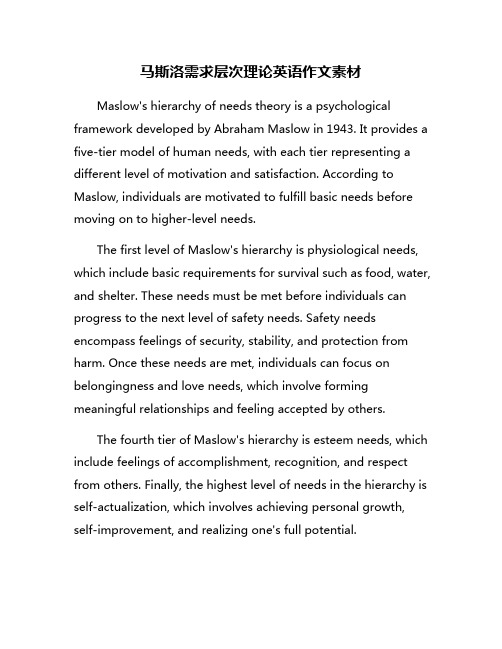
马斯洛需求层次理论英语作文素材Maslow's hierarchy of needs theory is a psychological framework developed by Abraham Maslow in 1943. It provides a five-tier model of human needs, with each tier representing a different level of motivation and satisfaction. According to Maslow, individuals are motivated to fulfill basic needs before moving on to higher-level needs.The first level of Maslow's hierarchy is physiological needs, which include basic requirements for survival such as food, water, and shelter. These needs must be met before individuals can progress to the next level of safety needs. Safety needs encompass feelings of security, stability, and protection from harm. Once these needs are met, individuals can focus on belongingness and love needs, which involve forming meaningful relationships and feeling accepted by others.The fourth tier of Maslow's hierarchy is esteem needs, which include feelings of accomplishment, recognition, and respect from others. Finally, the highest level of needs in the hierarchy is self-actualization, which involves achieving personal growth, self-improvement, and realizing one's full potential.Maslow believed that individuals strive to fulfill each level of needs in a sequential order, with higher-level needs becoming more prominent once lower-level needs are satisfied. However, he also recognized that individuals may prioritize different needs depending on their personal circumstances and life experiences.Maslow's hierarchy of needs theory has been widely influential in psychology, education, and business management. It has provided a useful framework for understanding human motivation, behavior, and personal development. By recognizing the diverse needs of individuals and the importance of meeting these needs, individuals and organizations can better support personal growth and well-being.In conclusion, Maslow's hierarchy of needs theory offers valuable insights into the complex nature of human motivation and satisfaction. By recognizing and addressing the diverse needs of individuals, we can create environments that promote personal growth, fulfillment, and overall well-being.。
《管理学英语》参考译文Unit 2

Unite 2. Significance of Management管理的重要性Read the following questions first, which will help you understand the text below better, and then answer the questions after reading the text carefully.先看看下面的问题,这些问题将有助于你更好地理解后面的课文,仔细地读完课文后再回答这些问题。
1. How do you understand the sentence "This interdependence, and the prominent role of organizations in our lives, highlights the importance of management."?你怎么理解这句话:组织的杰出作用和组织之间的相互依赖性突出了管理的重要性。
2. Why do you think management is important for an organization? Please describe the reason in great detail.为什么你认为管理对一个组织是重要的?请详细地描述一下原因。
3. What is the essence of management theory in your viewpoint?你的观点中,管理理论的本质是什么?Simply speaking, management is what managers do. But in order to understand the definition of management, that statement seems too simple. To our great surprise, the variety of approaches to management analysis, the amount of research, and the great number of differing views have resulted in much confusion as to what management is, what management theory and science is, and how managerial events should be analyzed. As a matter of fact, Harold Koontz many years ago called this situation "the management jungle". Though new approaches have developed and older approaches have taken on some new meanings with some new words attached, the developments of management science and theory still have the characteristics of a jungle. Thus in this passage we want to discuss Importance of Management, Definition of Management, and Major functions of Management respectively.简单地说,管理就是管理者所做的事情。
管理学-管理学关键词中英文对照
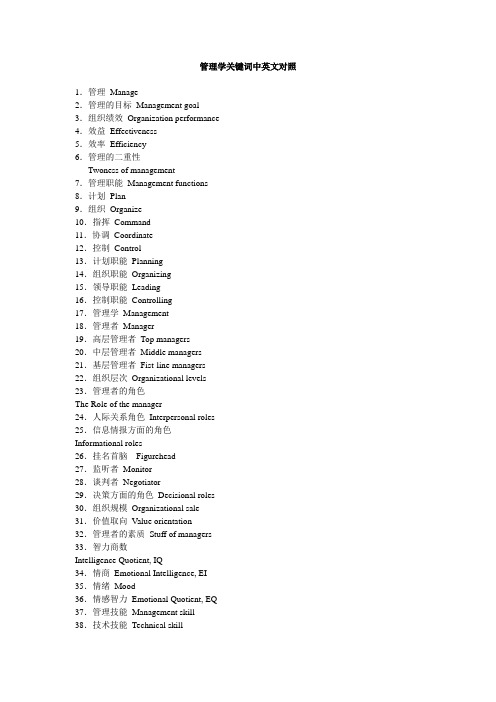
管理学关键词中英文对照1.管理Manage2.管理的目标Management goal3.组织绩效Organization performance4.效益Effectiveness5.效率Efficiency6.管理的二重性Twoness of management7.管理职能Management functions8.计划Plan9.组织Organize10.指挥Command11.协调Coordinate12.控制Control13.计划职能Planning14.组织职能Organizing15.领导职能Leading16.控制职能Controlling17.管理学Management18.管理者Manager19.高层管理者Top managers20.中层管理者Middle managers21.基层管理者Fist-line managers22.组织层次Organizational levels23.管理者的角色The Role of the manager24.人际关系角色Interpersonal roles25.信息情报方面的角色Informational roles26.挂名首脑Figurehead27.监听者Monitor28.谈判者Negotiator29.决策方面的角色Decisional roles30.组织规模Organizational sale31.价值取向Value orientation32.管理者的素质Stuff of managers33.智力商数Intelligence Quotient, IQ34.情商Emotional Intelligence, EI35.情绪Mood36.情感智力Emotional Quotient, EQ37.管理技能Management skill38.技术技能Technical skill39.人际技能Human skill40.概念技能Conceptual skill41.劳动分工Divide of labor42.劳动生产力Prolificacy of work43.劳动时间Time of work44.科学管理理论Scientific management theory 45.工业革命Industrial revolution46.泰罗制Taylor’s Principles47.时间研究Labor time study48.动作研究Motion study49.一般管理理论General administrative theory 50.管理原则Principles of management51.行政组织理论Administrative organization theory 52.古典组织理论Classical organization theory 53.行政管理Administrative management54.官僚制Bureaucracy55.官僚行政组织Bureaucracy56.行为科学Behavior science57.霍桑效应Hawthorne effect58.组织行为Organization behavior59.行为科学理论Behavior school60.X –Y 理论Theory X Y61.X理论Theory X62.Y理论Theory Y63.管理理论丛林Management theory jungle64.管理过程学派Management process school 65.人际关系学派Human relation school66.人际关系Human relation67.群体行为学派Group behavior school68.经验(或案例)学派Experience school69.社会合作系统学派Social technical systems theory 70.社会技术系统学派Social technical systems theory 71.系统管理学派Systems theory school72.决策理论学派Decision theory school 73.管理科学学派Management science school 74.权变理论学派Contingencies theory school 75.权变Contingencies76.经理角色学派Manager role school77.企业文化Organization culture78.愿景Vision79.共同愿景Shared vision80.文化冲击Culture shock81.公司再造Company Reengineering82.准时生产(JIT)Just-in-time83.计算机集成制造系统(CIM)Computer integrated manufacturing 84.精益生产Lean manufacturing85.学习型组织Learning organization86.管理环境Managerial environment87.外部环境External environment88.内部环境Internal environment89.一般环境因素General environmental factors90.宏观环境因素Macro environmental factors91.直接作用因素Direct-action factors92.间接作用因素Indirect-action factors93.环境的复杂性Environmental complexity94.动态环境Dynamic environment95.PEST分析法, PEST(polictial,economic,social,technological) 96.政治与法律环境Political & Legal environment97.特殊任务环境Specific environment98.供应商Suppliers99.服务对象Service object100.顾客Customer101.竞争对手Competitors102.潜在竞争对手Potential competitors103.竞争环境Competitive environment104.竞争意识Competitive intelligence105.进入障碍Barriers to entry106.规模经济Economies of scale107.范围经济Economies of scope108.政府管理部门Government Management department109.特殊利益团体Special-interest groups110.组织内部环境Organizational environment111.组织文化Organizational culture112.使命Mission113.凝聚力Cohesiveness114.合作Collaboration115.核心竞争力Core competence116.环境设计Design for environment117.组织设计Organizational design118.社会责任Social responsibility119.社会义务Social obligation120.社会响应Social responsiveness121.管理道德Management ethics122.道德规范Morality rule123.伦理Ethics124.可持续发展Sustainable development125.全球化Globalization126.全球组织模式Global organization model127.全球性组织Global organization128.全球性外包Global outsourcing129.全球战略Global strategy130.组织利益相关者Stakeholders131.组织Organization132.组织绩效Organizational performance133.生产型组织Manufacture organization134.服务型组织Service organization135.私人组织Private organization136.公共组织Commonality organization137.正式组织Formal organization138.非正式组织Informal organization139.实体组织Entity organization140.虚拟组织Virtual organization141.商业计划Business plan142.企业家Entrepreneur143.企业家才能Entrepreneurship144.创业Entrepreneurship145.创业机会分析Opportunity analysis146.组织目标Organizational goals147.研究与开发(R&D)Research and development 148.目标管理(MBO)Management by objective 149.企业Enterprise150.小企业Small business151.企业法人Corporation152.组织的法律形式Legal forms of organization 153.独资企业Solely- invested enterprise154.个人业主制企业 Sole proprietorship155.合伙制企业Partnership enterprise156.公司制企业Corporation157.有限责任公司Limited liability partnership 158.股份有限公司Limited liability Company 159.无限公司Unlimited company160.两合公司Limited partnership161.企业集团Group company162.劳动密集型企业Labor denseness enterprise 163.资金密集型企业Capital denseness enterprise 164.知识密集型企业Knowledge denseness enterprise 165.股东Shareholder166.董事Director167.董事会Directorate168.监事Monitor169.总经理General manager170.首席执行官(CEO)Chief executive officer171.非营利性组织Nonprofit organitation172.企业生命周期The corporate lifecycles173.发展Development174.萌芽阶段Embryonic stage175.衰退阶段Decline stage176.环境的不确定性Environmental uncertainty 177.组织变革Organization transform178.障碍Obstacle179.核心能力Core competencies180.战略Strategy181.战略管理Strategic management182.战略单位Strategic business units183.企业战略Enterprise strategy184.业务战略Business stratagem185.战略实施Strategy implementation186.差异化Differentiation187.差异化战略Differentiation strategy188.集中战略Concentration strategy189.一体化Intgeration190.纵向一体化V ertical integration191.同业多样化战略Concentric diversification strategy 192.战略联盟Strategic alliance193.合作战略Cooperative strategies194.机会Opportunities195.威胁Threats196.优势Strengths197.劣势Weaknesses198.风险Venture199.SWOT分析SWOT analysis200.成长战略Growth strategies201.稳固战略Stability strategies202.撤退战略Retrenchment strategies203.战略方针Strategic policy204.战略目标Strategic goles205.战略步骤Strategic process206.战略重点Strategic keystone207.战略措施Strategic measure208.预测Forecasting209.长期预测Long-time forecast210.中期预测Metaphase forecast211.短期预测Short-time forecast212.定性预测方法Qualitative forecast213.定量预测方法Quantitative forecast214.德尔菲法Dalphi Method215.讨论Discussion216.集合意见法Jury of opinion217.头脑风暴法Brainstorming218.时间序列法Time series analysis models 219.因果分析法Cause and effect analysis models 220.回归分析预测法Regression modals221.决策Decision222.决策过程Decision –making process 223.问题Problem224.决策标准Decision criteria225.权重Weights226.备选方案Alternatives227.最优化决策Optimum decision228.满意Satisfied229.评价Evaluating230.直觉决策Intuitive decision231.定性决策Qualitative decision232.定量决策Quantitative decision233.战略决策Stratagem decision making234.战术决策Tactics decision235.程序化决策Programmed decision236.非程序化决策Nonprogrammed decision 237.确定型决策Certain decision238.风险型决策Risk decisions239.不确定型决策Uncertain decision240.长期决策Long-term decision241.中期决策Intermediate-term decision242.短期决策Short-term decision243.个人决策Person decision244.集体决策Group decision245.有限理性Bounded rationality246.量本利分析法Breakeven analysis247.盈亏平衡点Breakeven point248.固定成本Fixed costs249.变动成本Variable costs250.决策树Decision tree251.悲观决策法Pessimistic decision252.乐观决策法Optimistic decision253.折衷决策法Compromise decision254.机会均等决策法Occasion equalization decision 255.最小后悔值决策法Regardless decision 256.计划Plan257.执行计划Execute plan258.宗旨Aim259.使命Mission260.目标Goal261.战略Stratagem262.政策Policy263.程序Process264.规则Rule265.规划Program266.项目Project267.预算Budget268.环境扫描Environmental scanning269.长期计划Long-term plans270.中期计划Intermediate-term plans271.短期计划Short-term plans272.战略计划Strategic plans273.业务计划Operational plans274.综合计划Synthetic plans275.局部计划Department plans276.项目计划Project plans277.高层管理计划Top management plans278.中层管理计划Middle management plans279.基层管理计划Fist-line management plans280.生产计划Manufacture281.供应计划Provide plans282.新产品开发计划New product plan283.营销计划Marketing plans284.财务计划Finance plans285.人事计划Human plans286.情境计划Scenario planning287.后勤保障计划Service ensure plans288.指令性计划Mandatory plans289.指导性计划Directional plans290.派生(辅助)计划Derivative plans291.甘特图Gantt chart292.滚动计划方法Rolling plan technique293.网络计划技术Network plan technique294.项目评审法(PERT) Program Evaluation and review techniques 295.线性规划Linear programming296.组织Organizing297.组织结构Organizational structure298.组织工作Organize299.劳动分工Division of labor300.统一指挥Unity of command301.职权Authority302.职责Accountability303.直线权力Line authority304.参谋权力Staff authority305.职能权力Function authority306.组织设计Organizational design307.组织结构设计Organizational structure design 308.组织手册Organization handbook309.职位说明书Job description310.组织系统图Organization system chart 311.组织规模Organization scale312.机械式的结构Mechanistic organization 313.单件生产Unit production314.小量生产Small production315.成批生产Process production316.大量生产Mass production317.连续生产Continuum production318.目标原则Goal principle319.管理幅度Span of control320.指控链Chain of command321.管理层次Chain of command322.岗位设定Job design323.工作分析Job analysis324.岗位设定Job design325.岗位轮换Job rotation326.多样化培训Diversity training327.岗位扩大化Job enlargement328.岗位丰富化Job enrichment329.部门划分Departmentalization330.部门化Departmentalization331.职能部门Functional department332.产品部门化Product departmentalization 333.地区划分部分Geographical departmentalization 334.顾客划分部门Customer departmentalization 335.管理者的能力Ma nager’s ability336.扁平型组织Flattening organization337.锥型组织Awl organization338.组织构架Organizational architecture339.机械式组织Mechanistic organization340.有机式组织Organic organization341.集权Centralization of state power342.集权组织Centralized organization343.分权Decentralization of state power344.分权组织Decentralized organization345.委员会制Committee system346.直线制组织结构Line strcture347.职能制组织结构Functional structure348.直线职能制组织结构Line-functional structure349.事业部制组织机构Divisional structure350.矩陈制组织结构Matrix structure351.专门工作组Bottlegging352.模拟分权制组织Simulation Decentralized organization 353.网络结构Network structure354.领导Leading355.领导Leadership356.职位权力Position power357.个人影响Referent power358.合法权Legitimate authority359.奖赏权Reward power360.惩罚权Punish right361.模范权Exemplary right362.专长权Specialty right363.魅力权Glamour right364.感情权Affection right365.士气Morale366.领导风格Leadership styles367.专制作风Autocratic styles368.民主作风Democratic styles369.放任作风Laissez-faire styles370.领导行为理论Behavioral approach371.管理方格图Managerial grid chart372.贫乏型管理Impoverished management373.任务型管理Task management374.俱乐部型管理Country club management375.中庸型的管理Middle –of –the- road management 376.团队型的管理Team management377.领导权变理论Contingency theory378.菲德勒的权变理论Fiedler contingency model379.“任务导向型”的领导方式Task –oriented leadership 380.“关系导向型”的领导方式Relationship-oriented leadership 381.菲德勒模型The Fiedler model382.情境领导理论Situational leadership theory383.途径——目标理论Path –goal theory384.教练Coach385.指导Coaching386.授权Authorization387.沟通Communicate388.消息Message389.渠道Channel390.传言链Grapevine chains391.语言沟通Verbal communication392.非语言沟通Nonverbal communication393.身体语言Body language394.过滤Filtering395.正式沟通Formal communication396.非正式沟通Informal communication397.小道消息Grapevine398.横向沟通Horizontal communication399.单向沟通One –way communication400.对上沟通Upward communication401.对下沟通Downward communication402.斜向沟通Diagonal communication403.沟通网络Communication network404.链式沟通网络Chain communication network 405.环式沟通网络Round communication network 406.Y式沟通网络Y communication network407.纵向沟通网络Vertical communication network 408.轮式沟通网络Wheel communication network 409.全通道式沟通网络All channel communication network 410.团队管理Team management411.激励Motivation412.激励因素Motivators413.需求Needs414.诱因Inducement415.动机Motivation416.行为Action417.绩效Performance418.激励理论Motivation theory419.内容型激励理论Content motivation theory420.积极性Enthusiasm421.需求层次理论Hierarchy of needs theory422.需求Need423.需求层次Need hierarchy424.生理需要Physiological needs425.安全需要Safety needs426.社交需要Social need427.尊重需要Esteem need428.自我实现需要Self –actualization needs 429.“ERG”理论ERG theory430.存在需要Existence need431.关系需要Relatedness need432.成长需要Growth need433.成就激励论Three-need theory434.成就需要Need for achievement435.权力需要Need for power436.合群需要Need for affiliation437.双因素理论Two –factors theory438.激励——保健理论Motivation –Hygiene theory 439.保健因素Hygiene factors440.激励因素Motivation factors441.满意Satisfaction442.不满意Dissatisfaction443.过程型激励理论Process motivation theory 444.期望Expectancy445.期望理论Expectancy theory446.效价Valence447.努力Make great efforts448.期望Expectation449.公平理论Equity theory450.投入Input451.产出Outcomes452.公平Equity453.不公平Inequity454.外在强化Extrinsic rewards455.内在强化Intrinsic rewards456.强化理论Reinforcement theory457.正强化Positive reinforcement458.负强化Negative reinforcement459.规避性学习Avoidance learning460.修正行为Behavior modification461.搭便车Hitchhike462.投机心理Venture psychology463.消退Fade away464.目标激励法Goal –setting theory465.报酬激励法Reward –setting theory466.工资Wage467.津贴Allowance468.认可Certificate469.赞赏Admiration470.奖惩Rewards and punishment471.惩罚Punishment472.考评Appraise473.控制Control474.控制系统Control system475.信息Information476.反馈Feedback477.信息反馈Information feedback478.控制论Cybernectics479.偏差Warp480.纠正Rectify481.前馈控制Feedforward control482.实时控制Real-time control483.反馈控制Feedback control484.业绩考核Performance appraisals 485.财务报表Financial statement486.资产负债表Balance sheet487.损益表Income statement488.现金流量表Statement of cash flow 489.预算Budgeting490.预算控制Budgeting control491.财务预算Financial budget492.业务预算Operation budget493.销售预算Sell budget494.生产预算Production budget495.生产进度日程表Production schedule table 496.内部审计Internal audit497.外部审计External audit498.创新Innovation499.技术创新Technoiogical innovations 500.产品创新Product innovation501.流程再造Process reengineering502.产品设计Product design503.首席技术官Chief technology officier。
管理英文版文档全文免费阅读、在线看
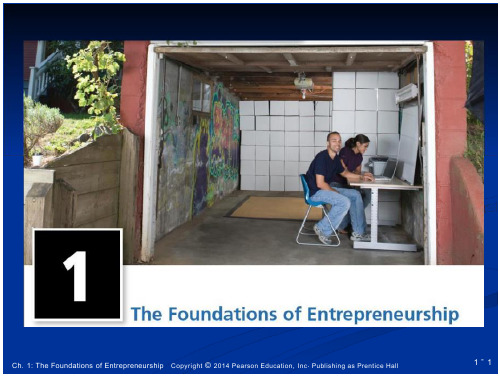
■ Demographic and economic factors■ Shift to a service economy■ Technology advancements■ Independent lifestyle■ The Internet and cloud computing
■ Create more jobs than big businesses.► 65% of net new jobs over the last decade
©
1 - 24
Small Businesses by IndustryCh 1: The Foundations of Entrepreneurship © . 1 - 25
©
1 - 5
capitalize on them.Ch 1: The Foundations of Entrepreneurship © . 1 - 6
and assembling the necessary resources to
■ Women entrepreneurs■ Minority-owned enterprises
■ Immigrant entrepreneurs■ Part-time entrepreneurs
©
1 - 22
■ 3% of small companies create 70% of net new jobs in theeconomy.► Gazelles (>20% growth, $100K+ sales)
©
1 - 2
Ch 1: The Foundations of Entrepreneurship © . 1 - 3
Ch 1: The Foundations of Entrepreneurship © . 1 - 4
管理学罗宾斯11版中英文对照详解
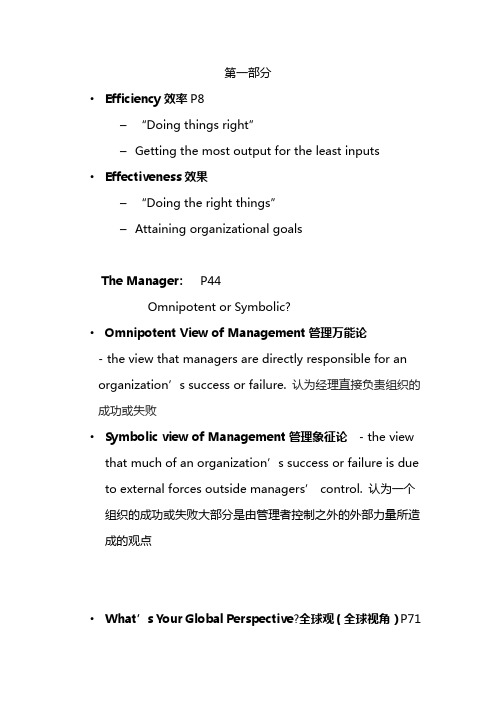
第一部分•Efficiency效率P8–“Doing things right”–Getting the most output for the least inputs •Effectiveness效果–“Doing the right things”–Attaining organizational goalsThe Manager: P44Omnipotent or Symbolic?•Omnipotent View of Management管理万能论- the view that managers are directly responsible for an organization’s success or failure.认为经理直接负责组织的成功或失败•Symbolic view of Management管理象征论- the view that much of an organization’s success or failure is due to external forces outside managers’ control.认为一个组织的成功或失败大部分是由管理者控制之外的外部力量所造成的观点•What’s Your Global Perspective?全球观(全球视角)P71•Parochialism狭隘主义- viewing the world solely through your own perspectives, leading to an inability to recognize differences between people.•Ethnocentric Attitude民族中心论- the parochialistic belief that the best work approaches and practices are those of the home country.本国取向•Polycentric Attitude多国论- the view that the managers in the host country know the best work approaches and practices for running their business.东道国取向•Geocentric Attitude全球中心论–a world-oriented view that focuses on using the best approaches and people from around the globe.全球取向•Multinational Corporation (MNC)跨国公司- a broad term that refers to any and all types of international companies that maintain operations in multiple countries. 任一或所有类型的在多国维持经营的国际性公司。
马斯洛需求层次理论英文版[优质ppt]
![马斯洛需求层次理论英文版[优质ppt]](https://img.taocdn.com/s3/m/0ceb158d65ce0508763213c9.png)
Self-actualization needs
The request of reaching one's full potential as a person. Never fully satisfied.
Realising personal potential, self-fulfillment, seeking personal growth, peak experiences, etc.
How are you motivated to satisfy these unmet needs in your life today?
Esteem needs Do a good job in team cooperation.
Self-actualization needs Take something I like and get really good at it.
When you start your first job, what kinds of motivation will you seek?
Physiological needs Meet my basic needs.
Safety needs Financial reserves, safety workplace.
Esteem needs Be respected.
What will motivate you to succeed in life?
Esteem needs Self-esteem and personal worth.
Self-actualization needs Curiosity about my potential.
《管理英语教程》翻译

第一部分基础第一单元管理与管理者Ⅰ管理的定义管理是指这样一种过程:通过与他人协作,有效地做好正确的事。
这里的“过程”指管理者履行的基础管理职能。
效率指正确地完成任务,同时也指投入与产出之间的关系。
例如,在给定投入的情况下,更高的产出就意味着效率得到了提高。
由于可供管理者们投入的都是稀缺资源,他们就必须考虑如何高效率地利用这些资源。
因此,管理者们要考虑的问题是如何将所投入的资源成本最小化。
尽管效率很重要,但仅仅顾及到效率还不够。
管理者还必须考虑效果的问题。
效果是指作正确的事。
在一个组织中,效果即指达成组织目标。
虽然效率与效果是两个不同的术语,但它们却相互联系。
例如,如果忽略效率则更容易做到有效果。
举例来说,一些政府部门常常受到批评的原因是他们的工作效果良好,但效率极其低下。
换言之,这些政府部门达成了工作目标,但为此所投入的成本过高。
那么一个组织是否会只有效率而无效果可言呢?例如,高效率地完成错误的任务。
因此,称职的管理者会同时考虑达成目标与尽可能高地提高效率。
Ⅱ管理的基本职能管理有四大基本职能:计划、组织、领导和控制。
我们常常将每个过程看成是独立的任务,但管理者必须能够同时执行这四大职能,并且认识到这四大职能会相互影响。
计划包括确定组织目标,规划整体战略,进一步制定可以整合与协调各种活动的具体计划。
制定目标可以使事情重点突出,并且使组织成员的注意力集中在最重要的问题上。
组织包括决定要完成的任务,由谁来做,任务如何分组,下级向谁报告以及在组织的哪个层级做出决策。
领导包括激励雇员,指导员工活动,组建最有效的沟通渠道,化解雇员之间的矛盾。
管理职能的第四项是控制。
在确定目标,制订计划,理清工作安排之后,仍然会有一些事情出现差错。
为了保证所有的行动都能按照计划进行,管理者必须监督组织的绩效表现。
必须要把组织的实际表现与所做出的计划相对比,如果两者之间出现明显的背离,管理者就有责任将组织活动纠正到正确的轨道上来。
马斯洛需求层次理论英文版

When you start your first job, what kinds of motivation will you seek?
Physiological needs Meet my basic needs. Safety needs Financial reserves, safety workplace. Esteem needs Be respected.
马斯洛需求层次理论英文版
What will motivate you to succeed in life?
Esteem needs Self-esteem and personal worth. Self-actualization needs Curiosity about my potential.
马斯洛需求层次理论英文版
How are you motivated to satisfy these unmet needs in your life today?
Esteem needs Do a good job in team cooperation. Self-actualization needs Take something I like and get really good at it.
马斯洛需求层次理论英文版
Thank you!
马斯洛需求层次理论英文版
此课件下载可自行编辑修改,供参考! 感谢你的支持,我们会努力做得更好!
马斯洛需求层次理论英文版
Self-actualization needs
The request of reaching one's full potential as a person. Never fully satisfied. Realising personal potential, self-fulfillment, seeking personal growth, peak experiences, etc.
马斯洛需求层次理论PDF
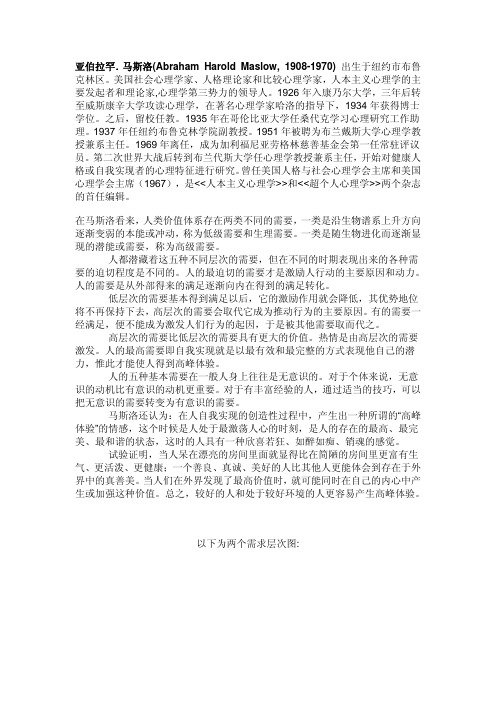
亚伯拉罕.马斯洛(Abraham Harold Maslow, 1908-1970)出生于纽约市布鲁克林区。
美国社会心理学家、人格理论家和比较心理学家,人本主义心理学的主要发起者和理论家,心理学第三势力的领导人。
1926年入康乃尔大学,三年后转至威斯康辛大学攻读心理学,在著名心理学家哈洛的指导下,1934年获得博士学位。
之后,留校任教。
1935年在哥伦比亚大学任桑代克学习心理研究工作助理。
1937年任纽约布鲁克林学院副教授。
1951年被聘为布兰戴斯大学心理学教授兼系主任。
1969年离任,成为加利福尼亚劳格林慈善基金会第一任常驻评议员。
第二次世界大战后转到布兰代斯大学任心理学教授兼系主任,开始对健康人格或自我实现者的心理特征进行研究。
曾任美国人格与社会心理学会主席和美国心理学会主席(1967),是<<人本主义心理学>>和<<超个人心理学>>两个杂志的首任编辑。
在马斯洛看来,人类价值体系存在两类不同的需要,一类是沿生物谱系上升方向逐渐变弱的本能或冲动,称为低级需要和生理需要。
一类是随生物进化而逐渐显现的潜能或需要,称为高级需要。
人都潜藏着这五种不同层次的需要,但在不同的时期表现出来的各种需要的迫切程度是不同的。
人的最迫切的需要才是激励人行动的主要原因和动力。
人的需要是从外部得来的满足逐渐向内在得到的满足转化。
低层次的需要基本得到满足以后,它的激励作用就会降低,其优势地位将不再保持下去,高层次的需要会取代它成为推动行为的主要原因。
有的需要一经满足,便不能成为激发人们行为的起因,于是被其他需要取而代之。
高层次的需要比低层次的需要具有更大的价值。
热情是由高层次的需要激发。
人的最高需要即自我实现就是以最有效和最完整的方式表现他自己的潜力,惟此才能使人得到高峰体验。
人的五种基本需要在一般人身上往往是无意识的。
对于个体来说,无意识的动机比有意识的动机更重要。
对于有丰富经验的人,通过适当的技巧,可以把无意识的需要转变为有意识的需要。
马斯洛需求层次理论英语作文素材
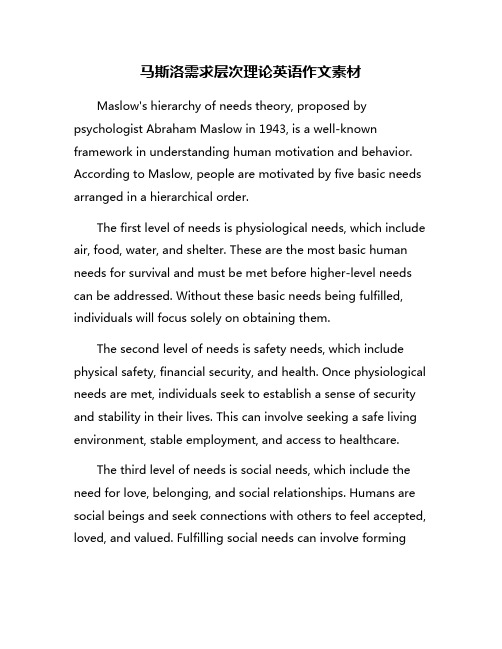
马斯洛需求层次理论英语作文素材Maslow's hierarchy of needs theory, proposed by psychologist Abraham Maslow in 1943, is a well-known framework in understanding human motivation and behavior. According to Maslow, people are motivated by five basic needs arranged in a hierarchical order.The first level of needs is physiological needs, which include air, food, water, and shelter. These are the most basic human needs for survival and must be met before higher-level needs can be addressed. Without these basic needs being fulfilled, individuals will focus solely on obtaining them.The second level of needs is safety needs, which include physical safety, financial security, and health. Once physiological needs are met, individuals seek to establish a sense of security and stability in their lives. This can involve seeking a safe living environment, stable employment, and access to healthcare.The third level of needs is social needs, which include the need for love, belonging, and social relationships. Humans are social beings and seek connections with others to feel accepted, loved, and valued. Fulfilling social needs can involve formingfriendships, participating in social activities, and maintaining close relationships with family and loved ones.The fourth level of needs is esteem needs, which include the need for self-esteem, confidence, and recognition from others. This level focuses on feelings of accomplishment, self-worth, and respect from others. Individuals seek to be appreciated for their skills, achievements, and contributions to society.The fifth and final level of needs is self-actualization, which involves reaching one's full potential and pursuing personal growth and fulfillment. Self-actualization is the highest level of the hierarchy, where individuals strive to become the best version of themselves and achieve their goals, dreams, and aspirations.Overall, Maslow's hierarchy of needs theory provides a comprehensive understanding of human motivation and behavior. By recognizing and fulfilling these five basic needs, individuals can work towards self-fulfillment and lead a meaningful and purposeful life.。
管理学英文版-重点大集合(概念、图表)

第一章1.管理职能:计划、组织、领导、控制。
management functions: planning、organizing、leading、controlling.2.管理角色〔management roles〕、①人际关系角色:挂名首脑、领导者、联络者Interpersonal:figurehead、leader、liaison②信息传递角色:监听者、传播者、发言人Informational: monitor、disseminator、spokesperson③决策制定角色:企业家、混乱驾驭者、资源分配者、谈判者Decisional: entrepreneur、disturbance handler、resource allocator、negotiator3、管理技能〔management skills〕概念技能、沟通技能、效果技能、人际技能Conceptual、communication、effectiveness、interpersonal4、组织的特点①有明确的目的〔distinct purpose〕②有人员构成〔people〕③有精细的结构〔deliberate structure〕第二章1、管理理论〔management theories〕:科学管理〔scientific management〕一般行政管理理论〔general administrative theorists〕定量方法〔quantitative approach〕组织行为〔organizational behavior〕系统观〔systems approach〕权变理论〔contingency approach〕第三章1、管理万能论〔omnipotent view of management〕管理象征论〔symbolic view of management〕2、组织文化的七个维度〔dimensions〕关注细节,成果导向,员工导向,团队导向,进取性,稳定性,创新与风险承受力Attention to detail, outcome orientation, people organization, team organization, aggressiveness, stability,innovation and risk taking 3、文化传播给员工的途径:故事,仪式,有形信条,语言Stories,ritual,material symbols,language4、创新的文化的特点①.挑战与参与〔challenge〕②. 自由〔freedom〕③. 信任和开发〔trust and openness〕④. 计划时间〔idea time〕⑤. 幽默〔playfulness/humor〕⑥. 冲突解决〔conflict resolution〕⑦. 讨论〔debates〕⑧. 冒险〔risk taking〕第六章1、决策制定过程〔the decision-making process〕①.识别决策问题〔identification of a problem〕②.确定决策标准〔identification of decision criteria〕③.为决策标准分配权重〔allocation of weight to criteria〕④.开发备份方案〔development of alternatives〕⑤.分析备份方案〔analysis of alternatives〕⑥.选择备择方案〔selection of an alternatives〕⑦.实施备择方案〔implementation of the alternatives〕⑧.评估决策结果〔evaluating decision effectiveness〕2、决策制定的错误〔decision-making errors and biases〕:自负〔overconfidence〕后见〔hindsight〕自利型〔self-serving〕沉没成本〔sunk costs〕随机性〔randomness〕典型性〔representation〕有效性〔availability〕框架效应〔framing〕证实〔confirmation〕选择性认知〔selective perception〕锚定效应〔anchoring effect〕即时满足〔immediate gratification〕4、计划工作〔planning〕:①、定义组织目的〔defining the organization’s goals〕②、制定全局战略〔establishing an overall strategy〕③、开发一组广泛的相关计划〔developing plans〕5、计划的目的〔purposes of planning〕:①、它给出了管理者和非管理者努力的方向〔planning provides direction to managers and nonmanagers alike〕②、它通过迫使管理者具有前瞻性来降低不确定性〔planning reduce uncertainty by forcing managers to look ahead, anticipate change, consider the impact of change, and develop appropriate responses〕③、计划可以减少活动的重复和浪费〔planning minimizes waste and redundancy〕④、计划设定目标和标准,可以用于控制〔planning establishes the goals or standards used in controlling〕6、计划和绩效〔planning and performance〕①正式的计划工作通常带来较高的绩效、较高的资产回报率,以与其他积极的财富Formal planning is associated with positive financial results such as higher profits, higher return on assets, and so forth.②计划工作的质量以与实现计划的适当措施,通常要比计划工作本身对绩效的贡献更大Doing a good job of planning and implementing those plans play a bigger part in high performance than does the extent and amount of planning done.③正式计划并不必然的导致至高绩效,外部环境的影响通常是更关键的Formal planning didn’t lead to higher performance, the external environment often was the culprit.④计划与绩效的关系还受到计划时间结构的影响。
马斯诺需求层次理论-英文
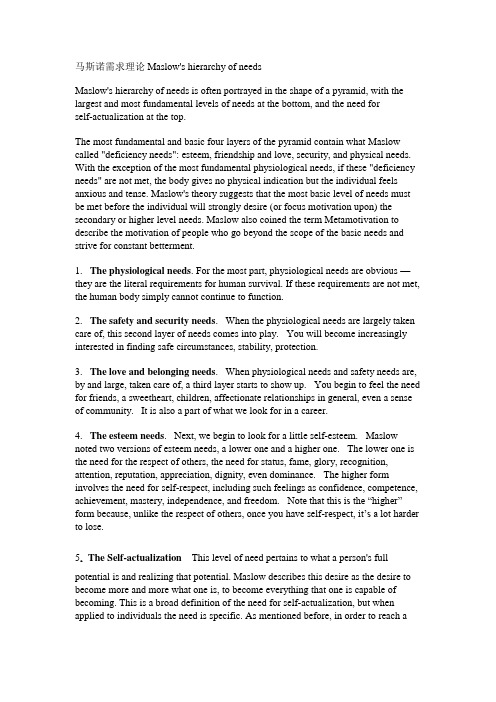
马斯诺需求理论Maslow's hierarchy of needsMaslow's hierarchy of needs is often portrayed in the shape of a pyramid, with the largest and most fundamental levels of needs at the bottom, and the need forself-actualization at the top.The most fundamental and basic four layers of the pyramid contain what Maslow called "deficiency needs": esteem, friendship and love, security, and physical needs. With the exception of the most fundamental physiological needs, if these "deficiency needs" are not met, the body gives no physical indication but the individual feels anxious and tense. Maslow's theory suggests that the most basic level of needs must be met before the individual will strongly desire (or focus motivation upon) the secondary or higher level needs. Maslow also coined the term Metamotivation to describe the motivation of people who go beyond the scope of the basic needs and strive for constant betterment.1. The physiological needs. For the most part, physiological needs are obvious —they are the literal requirements for human survival. If these requirements are not met, the human body simply cannot continue to function.2. The safety and security needs. When the physiological needs are largely taken care of, this second layer of needs comes into play. You will become increasingly interested in finding safe circumstances, stability, protection.3. The love and belonging needs. When physiological needs and safety needs are, by and large, taken care of, a third layer starts to show up. You begin to feel the need for friends, a sweetheart, children, affectionate relationships in general, even a sense of community. It is also a part of what we look for in a career.4. The esteem needs. Next, we begin to look for a little self-esteem. Maslow noted two versions of esteem needs, a lower one and a higher one. The lower one is the need for the respect of others, the need for status, fame, glory, recognition, attention, reputation, appreciation, dignity, even dominance. The higher form involves the need for self-respect, including such feelings as confidence, competence, achievement, mastery, independence, and freedom. Note that this is the “higher” form because, unlike the respect of others, once you have self-respect, it’s a lot harder to lose.5. The Self-actualization This level of need pertains to what a person's full potential is and realizing that potential. Maslow describes this desire as the desire to become more and more what one is, to become everything that one is capable of becoming. This is a broad definition of the need for self-actualization, but when applied to individuals the need is specific. As mentioned before, in order to reach aclear understanding of this level of need one must first not only achieve the previous needs, physiological, safety, love, and esteem, but master these needs。
(完整版)管理学—应用词汇中英文对照表

管理学词汇中英文对照Accou ntability 责任感Achievement-oriented leadership 成就取向型领导Activity ratio 活动比率Adaptive organization (horizontal corporation) 自适应组织Administrative management 行政管理Affiliation needs 归属的需要Aggregate planning 综合计戈UAlter native courses of acti on 可供选择的行动Artifacts人工环境Assessme nt cen ter 评价中心Assets资产Attitudes 态度Authority 职权Aut onomy 自治Bala nee sheet资产负债表BCG matrix波士顿咨询集团矩阵Behavior modificati on 行为修正Behavioral approach 行为法Behavioral decision model 行为决策模型Boundary-spanning roles 跨界角色Boun ded rati on ality 有限理性Brainstorming 头脑风暴法Breakeven analysis 头脑风暴法Budgets 预算Bureaucratic control 官僚控制Bureaucratic management 官僚管理Bus in ess ethics 商业道德Busi ness portfolio matrix 商业资产组合矩阵Busi ness strategy 商业策略Cash cows金钱牛Chain of comma nd 指挥链Changing 变革Charismatic authority 魅力权威模式Classical perspective 古典管理理论Closed system圭寸闭系统Code of ethics伦理规范Coercive power 强制力Cohesive ness 凝聚力Communication 沟通Communi cati on n etwork 沟通网Compensation 报酬Competitive advantage 竞争优势Computer-aided software engin eeri ng (CASE) 计算机辅助设计Conceptual skill 概念能力Concurrent control 并行控制Constraints强制,约束Contingency approaches 随即制宜法Contingency perspective 权变观Con ti ngency pla nning 随即计戈U Continuous schedule of reinforcement 连续性奖励Con ti nu ous-flow product ion system 连续生产系统controlling控制职能Controls 控制Corporate social responsibility 公司社会责任Corporate strategy 公司战略Cost leadership strategy 成本领先战略Current assets 流动资产Curre nt liabilities 流动负债Customer divisional structure 消费者多样化结构Data数据Debt ratios负债比率Decision making 决策Decision support system (DSS)决策制定系统Decision tree决策树(体系)Decision varialbes 决策变量decisional roles 决策角色Decoding 解码Delegation 授权Delphi technique魔鬼提倡法Devil's advocacy唱反调的人Dialectical inquiry 辩证探求法Differention strategy 差异化战略Directive leadership 指示领导Diversity多样化Divisional structure 部门是结构Dogs瘦狗Downward com muni cati on 下行沟通Dynamic network 动态网络Econo mic feasibility 经济可行性Effectiveness 效果Efficiency 效率Electro nic data in tercha nge (EDI) EDI 电子数据交换Electronic funds transfer (EFT)电子资金转换Electro nic mail (e-mail)电子邮件Employee assistanee programs (EAPs)员工辅助项目顾问Employee-centered work redesign 员工工作再设计Employment test 就业测试Empowering employees 职工授权Encoding 编码End users终极用户Entropy衰退趋势Escalation of commitment 递增效忠Esteem n eeds 尊重的需要Ethical behavior 道德表现Ethical dilemma 伦理困境Ethics伦理Expectancy 期望Expected monetary value (EMV)预期货币价值Expected value 预期价值Expert power专家权力Expert system专家系统Exter nal com muni cati on 夕卜部环境External customer 外部顾客External forces夕卜部力量Extinction 废止Feedback 反馈Feedback 反馈Feedback 反馈Feedback (corrective) control 反馈校正控制Feedback con trols 反馈控制Feedforward (preventive) control 前馈预防控制Feedforward controls 前馈控制Fixed assets固定资产Fixed-interval schedule 定时给奖Fixed-positi on layout 定位式布置Fixed-ratio schedule 定比给奖Focus strategy 集中战略Force-field analysis 立场分析Formal groups正式群体Functional manager 职能管理者Functional strategy 职能管理者Functional structure 职能式战略GE matrix职能式结构Gen eral environment —般环境General manager 总经理Generic strategies 一般性策略Geographic divisional structure 全球多样化战略Global strategy全球化战略Goal setting目标结构Goals目标Grand strategy 主战略Grapevine藤状网络式沟通Group群体Groupthink群体思想Groupware 群件Halo-and-horn effect 月晕效应Hawthorne effect 关注作用Huma n resource in formatio n systems (HRISs) 人力资源信息系统Huma n resource man ageme nt 人力资源管理Human resource planning 人力资源计戈U Human rights approach 人权方法Human skills 人工技巧Hybrid layout混合式布置Hygiene factors 保健因素hypercha nge极度改变In come stateme nt 损益表In formal groups 非正式群体Information 信息In formatio n overload 信息过量Information power 信息权力In formati on tech no logy 信息技术In formati onal roles 信息角色In puts投入Instrumental values 工具价值Instrumentality媒介;工具;手段Intangible costs 无形成本Integrating mechanisms 结合机制In terdepe ndence 互相依赖Internal customer 内部顾客Internal forces 内力Internal network 内部网络Interpersonal roles人际交往能力Intuition 直觉Jargon行话Job analysis工作分析;工种分析Job depth工作深度Job description 工作说明Job description 工作说明Job desig n工作设计Job enl argeme nt工作扩大化Job enrichment工作丰富化Job rotation岗位轮换Job satisfaction 工作满意Job scope工作丰富化Job specifications工作规范;操作规程Job-shop production system 职务专业化Justice approach公正合理观Just-in-time (JIT) inventory management 及时存货系统Labor-management relations 劳工管理关系Lan guage systems and metaphors 语言习惯Lateral com muni cati on 横向沟通Law of effect效应法则Law of requisite variety 必要多样性定律Leadership 领导Leadership substitutes 领导替代leading 领导Least preferred coworker (LPC)scale 最不喜欢的同事Legitimate power 法定权禾ULiabilities 负债Line personnel线形人事管理Liquidity ratios 流动率Local-area network (LAN) 局域网Locus of control 控制点Locus of decisi on making 局域网Lon g-term liabilities 长期债务Machiavellian personality 马基雅弗利人格理论Management 管理Management by exception 例外管理Man ageme nt by objectives (MBO) 目标管理责任制Man ageme nt in formatio n system (MIS) 信息管理系统Man agers 经理Master product ion schedule 主生产排程Matket growth rate 市场增长率Matrix structure 矩阵结构Mechanistic systems 机械式组织Medium载体Messages 消息Motivatio n 激励Motivator factors 激励因素Multidomestic strategy 多元化策略Myths虚构的故事Need for achievement 成就需要Negative reinforcement 消极强化Network structure 网络结构Noise噪声Nomi nal group tech nique (NGT) 名义群体技术Non programmed decisi on 非程序化决策Non verbal com mun icati ona 非语言沟通Norms标准;规范;典范;限额Objectives 目标Objectives fun ctio n 目标函数Ope n system开放系统Operatio nal feasibility 造作可行性Operational plan 作业计划Operational planing作业计划职能Opportunity 机遇Oral com muni cati on 口头交流Organic (cla n) con trol 有机控制Organic system 有机系统organization组织安排Organizational change 组织变革Organi zati onal con trol 组织控制Organizational culture 组织文化Organizational design 住址决策Orga nizatio nal developme nt (OD) 组织发展Orga ni zatio nal feasibility 组织可行性Organizational mission 组织使命Organizational structure 组织结构Organizing 组织Orientation 定位Outputs 产出Owner's equity所有者权益Partial schedule of reinforcement 间断性奖励Participative leadership 参与型领导Participative management 参与管理Path-goal model途径-目标模型Payoff table 决定(因素)表;结算表咸果表Payoffs发工资Performanee appraisal 绩效考评Personality 性格PERT(program Evaluati on and review technique)计划审评技术Physiological needs 生理的需要Plan计划planning计划,部署Policies 政策Pooled in terdepe ndence 共有相互依存Positive reinforcement 正强化Power权利Problem 问题Procedures 程序Process con sultati on 过程咨询Process layout工艺式布置Product divisio nal structure 生产部门式结构Product layout产品式布置Productivity 生产力Profitability ratios 收益比率Programmed decision 程序化决策Programs 规划Project product ion system 工程生产系统Projects 项目Protected class 受保护一类Punishment 惩罚Quality assura nee 质量保证Quality circle QC 小组Quality control质量管理;质量控制Quality management 质量管理Question marks 问号Rati on al-ec ono mic decisi on model 理性经济决策模型Ratio nal-legal authority 法理权威模式Reciprocal interdependence 交互性的互赖性Recruitment 招聘Reengineering 工程再造Referent power 指示权力Refreezing再冻结阶段Relati on ship orie ntati on 关系导向Relationship-orientation roles 关系导向角色Relative market share 相关市场份额Repetitive, assembly-l ine, or mass-product ion system重复性、流水线、大量生产系统Responsibility 职责Restraining forces 阻力Reward power奖励权力Rites仪式Robotics机器人技术Roles任务,角色Rules规则Satisficing 满意性Scalar principle 等级原则Schedules of reinforcement 强化时间表Scientific management 科学管理Security needs安全的需要Selection 选拔Selective perception 选择性理解Self-actualization needs 自我实现需要Self-esteem 自尊Self-management teams 自我管理小组Self-management teams 自我管理小组Self-mo nitori ng 自我控制Self-oriented roles自我取向角色Seque ntial in terdepe ndence 顺序式互赖Sexual harassme nt 性骚扰Sin gle-use pla ns —次性计划Skill vareity多种技能SLT model情境领导模型Social context社会关联性Span of control控制幅度,管理幅度Special-purpose team 特殊目标小组Stable environment 环境稳定Stable network 稳固网络Staff personnel员工人事管理Staffing人员雇佣;职工配备Stakeholders利益相关者Standing pla ns 长设计戈UStars明星States of nature 自然状态Stereotyping 典型化Stories 事迹Strategic analysis 战略分析Strategic control 战略控制Strategic decision-making matrix 战略决策矩阵Strategic goals 战略目标Strategic plan 战略计划Strategic plan 战略计划Strategic planning战略计划职能Strategic planning战略计划职能Strategy formulation 战略制定Strategy Implementation 战略实施Supportive leadership 支持型领导Survey feedback 调查反馈Synergy共同作用Systems analysis 系统分析Systems developme nt life cycle (SDLC) 发展周期系统Tan gible costs可收回成本Task environment 任务环境Task identity任务说明Task orientation任务导向型Task significanee 任务重要性Task-oriented roles任务导向型角色Team building团队建设Technical feasibility 技术可行性Technical skills 技术技能Telecommuting 远程办公Term in al values 终极价值Theory X (管理)X理论Theory Y (管理)Y理论Theory Z (管理)Z理论Total quality management (TQM) TQM 全面质里官理Total quality management (TQM) TQM 全面质里官理Traditio nal authority 传统权威模式Training 培训Trait approach 特征途径Transaction al leadership 执行性领导Transformation process 变革过程Turbulent environments 动荡环境Type A orientation A 型意向者Type B orientation B 型意向者Unfreezing 解冻Un ity of comma nd 统一指挥Upward com muni cati on 上行沟通Utility 即proach 功利主义观Vale nee 效价Validity 效度Values价值Variable-ratio schedule 变动比率增时制Varianee reporting 视频会议Videoconferencing 视频会议Vigilanee 警戒Whistleblower 揭发Wide-area network (WAN) 局域网Writte n com mun icatio n 笔头交流。
马斯洛需求层次理论在社会工作中的应用(英文版) Maslow’s hierarchy of needs theory
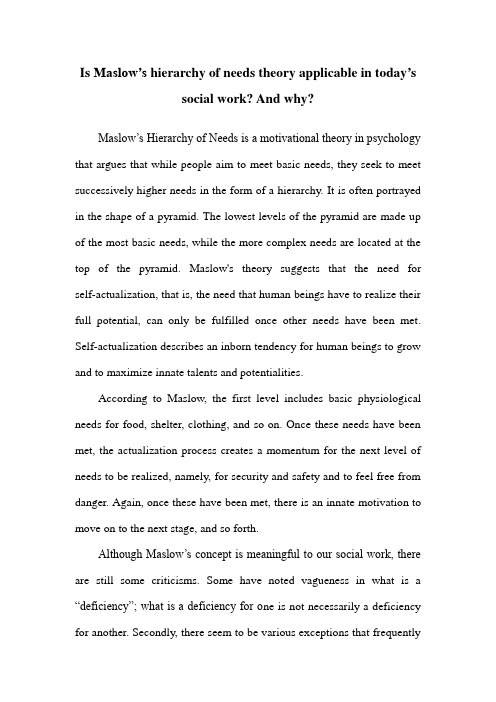
Is Maslow’s hierarchy of needs theory applicable in today’ssocial work? And why?Maslow’s Hierarchy of Needs is a motivational theory in psychology that argues that while people aim to meet basic needs, they seek to meet successively higher needs in the form of a hierarchy. It is often portrayed in the shape of a pyramid. The lowest levels of the pyramid are made up of the most basic needs, while the more complex needs are located at the top of the pyramid. Maslow's theory suggests that the need for self-actualization, that is, the need that human beings have to realize their full potential, can only be fulfilled once other needs have been met. Self-actualization describes an inborn tendency for human beings to grow and to maximize innate talents and potentialities.According to Maslow, the first level includes basic physiological needs for food, shelter, clothing, and so on. Once these needs have been met, the actualization process creates a momentum for the next level of needs to be realized, namely, for security and safety and to feel free from danger. Again, once these have been met, there is an innate motivation to move on to the next stage, and so forth.Although Maslow’s concept is meaningful to our social work, there are still some criticisms. Some have noted vagueness in what is a “deficiency”; what is a deficiency for o ne is not necessarily a deficiency for another. Secondly, there seem to be various exceptions that frequentlyoccur. For example, some people often risk their own safety to rescue others from danger. In their extensive review of research based on Maslow's theory, Wahba and Brudwell found little evidence for the ranking of needs Maslow described or even for the existence of a definite hierarchy at all. Chilean economist and philosopher Manfred Max-Neef has also argued fundamental human needs are non-hierarchical and invariant in nature—part of the condition of being human; poverty, he argues, may result from any one of these needs being frustrated, denied or unfulfilledThe order in which the hierarchy is arranged has been criticized as being ethnocentric by Geert Hofstede. Hofstede's criticism of Maslow's pyramid as ethnocentric may stem from the fact that Maslow’s hierarchy of needs neglects to illustrate and expand upon the difference between the social and intellectual needs of those raised in individualistic societies and those raised in collectivist societies. Maslow created his hierarchy of needs from an individualistic perspective, being that he was from the United States, a highly individualistic nation. The needs and drives of those in individualistic societies tend to be more self-centered than those in collectivist societies, focusing on improvement of the self, with self actualization being the apex of self improvement. Since the hierarchy was written from the perspective of an individualist, the order of needs in the hierarchy with self actualization at the top is not representative of theneeds of those in collectivist cultures. In collectivist societies, the needs of acceptance and community will outweigh the needs for freedom and individuality.Maslow’s hierarchy has also been criticized as being individualistic because of the position and value of sex on the pyramid. Maslow’s pyramid puts sex on the bottom rung of physiological needs, along with breathing and food. It views sex from an individualistic and not collectivist perspective. This view of sex neglects the emotional, familial and evolutionary implications of sex within the community.As Hayes said, Maslow’s model may provide a rough w orking generalization about most people in most situations, but it is not really adequate as an explanation of human motivation.It seems that a lot of social work principles are based on this pyramid; I would argue that most of the other helping professions only work at the top three rungs of the pyramid. Social workers often find themselves starting at the bottom two.While Maslow’s theory is useful, it is of course an oversimplification of real life, especially when you consider that a lot of human beings would rearrange this pyramid in one way or another. For example, a lot of people may feel that this pyramid should be arranged with self-esteem as the bottom rung. They may feel that once a person has achieved a modicum of self esteem, that everything else will fall intoplace, including the ability to take care of basic needs. I agree with that in principle.But a large percentage of social work stops at the bottom two rungs, with the remainder being taken care of by a referral to a professional who handles those parts of the pyramid.The question is what we can do as social workers to encourage a client to move up the pyramid. For example, a lot of people at the shelter do indeed stop at the first two rungs; they get stuck in a cycle in which they do leave the shelter either by being kicked out or getting assisted with housing, but somehow end up back at the bottom of the pyramid again. For whatever reason, is it trauma, poor life skills in general, or a bad example while growing up, they never can seem to get out of this cycle. And ethically, we can’t force them to.Is it a dependency issue, that is, do they prefer to be in this cycle? Or are their mental health issues so severe that they just can’t get out of the cycle? If so, why are there not better resources for handling these issues? It seems to not make any sense to provide for just the basic needs and stop there. The goal should be to allow clients to move farther up the pyramid, and to have the resources to do that. If not, our society is just perpetuating the problem by creating dependency when it comes to a person’s basic needs.So in social work we often encounter situations where if appearsvery difficult for some individuals to move their lives forward beyond the first two levels. The energy spent on trying to survive in the face of adversity necessarily means that emotional resources or energy are not free to be used on other courses of action, such as finding a job, sorting out school problems or meeting other needs. This has important implications for our work because it could mean that providing the right kind of practical or material assistance, or emotional support for service users, could release the momentum and motivation towards self-sufficiency and independence. Without this understanding, we run the risk of providing resources and services into a bottomless pit, where fundamental change does not happen.To conclude, although this theory has serious limitations, there is no doubt that Maslow’s hierarchy of needs theory is still applicable in today’s social work. I think what our social worker should do is to understanding this theory well and try our best to adapt it into our daily work. There must be a wide gap between theory and practical operation, which need us to consummate and find the balance through our experience.。
管理马斯洛--中文英文对照版.pdf
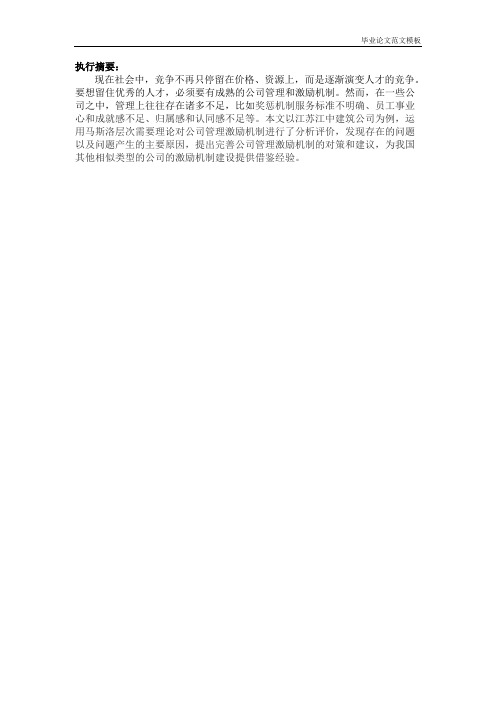
执行摘要:现在社会中,竞争不再只停留在价格、资源上,而是逐渐演变人才的竞争。
要想留住优秀的人才,必须要有成熟的公司管理和激励机制。
然而,在一些公司之中,管理上往往存在诸多不足,比如奖惩机制服务标准不明确、员工事业心和成就感不足、归属感和认同感不足等。
本文以江苏江中建筑公司为例,运用马斯洛层次需要理论对公司管理激励机制进行了分析评价,发现存在的问题以及问题产生的主要原因,提出完善公司管理激励机制的对策和建议,为我国其他相似类型的公司的激励机制建设提供借鉴经验。
目录1背景介绍 (1)1.1马斯洛需求层次理论 (1)1.2选取马斯洛需求层次理论的原因 (1)2.以江苏江中集团为例进行分析 (1)2.1公司基本情况 (1)2.2出现的问题 (2)2.2.1管理观念落后 (2)2.2.2管理与考核机制脱节 (2)2.2.3没有健全的员工培训体系 (2)2.3应用马斯洛层次需求理论探讨解决办法 (3)2.3.1满足员工生理需求、安全需求的激励措施 (3)2.3.2满足员工社会交往需求、尊重需求的激励措施 (3)2.3.3满足员工自我实现需求的激励措施 (3)3.总结建议 (4)4.参考文献 (4)1背景介绍1.1马斯洛需求层次理论马斯洛需求层次理论又称"基本需求层次理论",是由心理学家马斯洛提出。
马斯洛理论把需求分成生理需求、安全需求、归属与爱的需求、尊重需求和自选取马斯洛需求层次理论的原因之所以选择马斯洛层次需要理论,是因为马斯洛需求层次理论在一定程度上反映了人类行为和心理活动的共同规律。
马斯洛从人的需要出发探索人的激励和研究人的行为,抓住了问题的关键;马斯洛指出了人的需要是由低级向高级不断发展的,这一趋势基本上符合需要发展规律的。
大多数人的需要结构很复杂,无论何时都有许多需求影响着我们的行为。
一般来说,只有在较低层次的需求得到满足之后,较高层次的需求才会有足够的活力驱动行为。
满足较高层次需求的途径多于满足较低层次需求的途径。
组织行为学中英文词汇对照
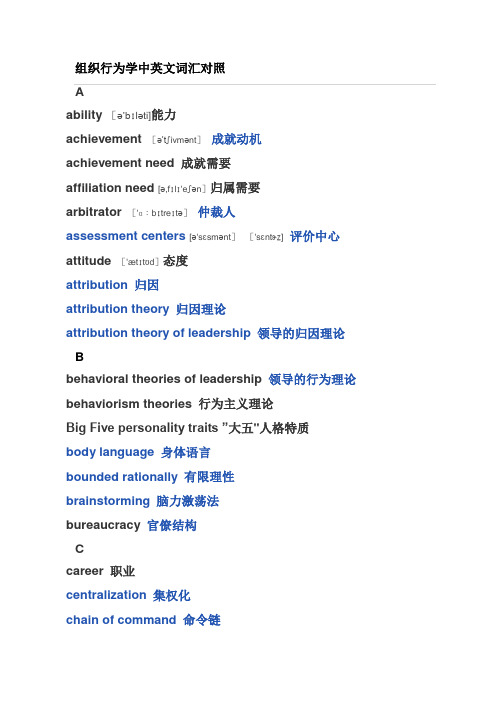
组织行为学中英文词汇对照Aability[ə’bɪləti]能力achievement [ə’tʃivmənt]成就动机achievement need 成就需要affiliation need [ə,fɪlɪ'eʃən]归属需要arbitrator ['ɑːbɪtreɪtə]仲裁人assessment centers[ə'sɛsmənt]['sɛntɚz]评价中心attitude ['ætɪtʊd]态度attribution归因attribution theory归因理论attribution theory of leadership领导的归因理论Bbehavioral theories of leadership 领导的行为理论behaviorism theories 行为主义理论Big Five personality traits ”大五"人格特质body language身体语言bounded rationally有限理性brainstorming脑力激荡法bureaucracy 官僚结构Ccareer 职业centralization集权化chain of command命令链charismatic leadership 领袖魅力的领导charismatic leadership theories魅力领导理论classical conditioning 经典条件反射cliques 小集团cognitive component of an attitude 态度的认知成分cognitive learning 认知学习cognitive theories 认知理论cohesiveness凝聚力collaborating协作command group命令型群体communication沟通communication apprehension沟通焦虑communication networks 沟通网络communication process沟通过程competence 能力competing 竞争compromising 折中conciliator 和解人conflict冲突conflict management冲突管理conflict process 冲突过程conformity 从众问题conscientiousness 责任心consideration 关怀维度consistency 一贯contingency approaches to management 管理的权变途径contingency leadership theory领导权变理论continuous reinforcement 连续强化contrast effects对比效应control theory控制理论controlling 控制core values核心价值观creativity创造力cross—functional teams多功能型团队cultural differences 文化差异Ddecision making决策decision rationality 决策理性decision role决策角色decision—making style 决策风格decisions 决策decoding 解码delegating style 授权风格Delphi technique 德尔菲技术Departmentalization部门化dispositional attributions 个性归因distributive bargaining分配谈判distributive justice 分配公平diversity 多元化dominant culture 主导文化downward communication下行沟通Dynamics of Synergy 协力优势dysfunctional conflict 功能失调的冲突Eeconomic rationality model 经济理性模型emotion 情绪emotional intelligence情绪智力emotional stability 情绪稳定性mployee involvement 员工参与employee-oriented leader 员工导向的领导者empowerment授权encoding 编码encounter stage 碰撞阶段engagement 卷入environment 环境equity theory公平理论equity theory of work motivation 工作动机的公平理论ERG theory ERG理论exchange leadership theories 领导的交换理论expectancy theory期望理论export power专家性权力external validity 外部效度externals 外控者extraversion 外向性extrinsic motive 外源性动机extrinsic rewards 外部报酬Ffeedback 反馈Fiedler contingency model 费德勒的权变模型filtering 过滤Five—Factor Model(FFM)五因素模型flexible benefits灵活福利formal group 正式群体formal networks 正式沟通网络formal organization正式组织function conflict 功能正常的冲突functional analysis 功能性分析fundamental attribution error 基本归因偏差Ggeneral mental ability(GMA) 一般心理能力goal conflict目标冲突goal setting 目标设定goal sharing 目标共享goal-setting theory目标设置理论group 群体group decision making群体决策group leadership theories领导的群体理论group stressors群体压力源group shift群体转移groupthink群体思维Hhalo effect晕轮效应Hawthorne effect霍桑效应Herzberg’s Two-Factor Theory of Motivation赫茨伯格的动机双因素理论horizontal organization扁平化组织human capital人力资本human relations views of conflict 冲突的人际关系观点hygiene factors 保健因素Iincentives 诱因informal groups非正式群体informal network 非正式沟通网络information richness 信息丰富性initiating structure 结构维度instrumental values 工具价值观integrative bargaining 综合谈判intergroup dynamics 组间动力integrity 正直intellectual ability心理能力intelligence activity 智力活动interacting groups 互动群体interactional view of conflict 冲突的相互作用观点interest group 利益型群体internal validity 内部效度internals 内控者interpersonal communication人际沟通interpersonal roles人际角色intrinsic motive 内源性动机intrinsic rewards 内部报酬intuition 直觉Jjob design工作设计job enlargement工作扩大化job enrichment工作丰富化job involvement 工作参与job rotation工作轮换job satisfaction工作满意度job specification 工作规范Kknowledge management知识管理Lleader role 领导角色leader-member exchange (LMX)theory 领导者-成员交换理论leader—member relations 领导者—成员关系leadership 领导eadership skill 领导技能learned helplessness习得性无助learning 学习learning organization学习型组织least preferred coworker (LPC) questionnaire 最难共事者问卷life—cycle approach生命周期理论lower—order needs 较低层次的需要loyalty 忠诚Mmanagement by objectives (MBO)目标管理Management Information System(MIS) 管理信息系统managerial communication model 管理沟通模型managerial grid管理方格论managerial grid style 管理方格风格managers管理者Maslow’s hierarchy of needs 马斯洛的需要层次理论means-ends chain途径-目标链monitor 监控者mood 心情motivation 激励multicultural organization 多元文化型组织Nneed 需要negative reinforcement负性强化neglect 忽略negotiation谈判negotiation skills 谈判技巧nominal group technique名义群体技术nonverbal communication非语言沟通normative commitment 规范承诺norms 规范Ooperant conditioning 操作条件反射organization 组织organizational behavior (OB)组织行为学Organizational Citizenship Behaviors(OCBs)组织的公民行为organizational commitment组织承诺organizational culture组织文化organizational development组织发展Organizational Hierarchies 组织层级organizational structure组织结构Pparticipating style 参与风格participative management参与式管理path—goal leadership theory路径—目标领导理论pay for performance绩效奖金perception 知觉perceptual context 知觉背景personality 人格personality traits 人格特质Porter Lawler motivation model波特-劳勒动机模型position power职位权力positive reinforcement正性强化power权力power motive权力动机power need 权力需要problem-solving teams问题解决型团队production—oriented leader 生产导向的领导者productivity 生产率profit sharing 利润共享projection投射psychological contract心理契约Qquality of life 生活质量quality of work life(QWL) 工作生活质量Rrationality 理性recognition 认可reengineering再造工程reinforcement theory强化理论reinforcers 强化物risky shift phenomenon 风险偏移现象role 角色role ambiguity角色模糊role conflict角色冲突role expectations角色期待role identity 角色同一性role perception角色知觉Ssecurity motive 安全动机selective perception选择性知觉self—actualization 自我实现self—esteem 自尊self—managed teams自我管理团队selling style 推销风格sensitivity training敏感性训练similarity 相似性Simmon's Bounded Rationality Model西蒙的有限理性模型situational attributions 情景归因situational leadership情境领导理论small groups 小群体social cognition theory 社会认知理论social learning 社会学习social loafing社会惰化social perception社会知觉social recognition 社会认可socialization process 社会化过程social-learning theory社会学习理论status 地位status motive 地位动机stereotyping刻板印象storming 震荡stress 压力strong culture 强文化subculture亚文化synergy 协同效应Ttask group任务型群体task structure 任务结构team团队team building团队建设team structure 团队结构terminal values 终极价值观Thematic Apperception Test(TAT)主题统觉测验theory X X理论theory Y Y理论traditional view of conflict冲突的传统观点trait theories of leadership领导的特质理论transactional leadership交易型领导者transformational leadership变革型领导者trust 信任turnover 流动type A personality A型人格Uupward communication上行沟通Vvalues 价值观virtual organization虚拟组织virtual teams虚拟团队Wwork group工作群体work specialization工作专门化专业词汇(葡语)1. desejos 愿望2. valores opostos,相反的价值观3. Diferentes sistemas de valores不同的价值体系4. negativamente afetado 负面影响5. tem que ser percebido 被感知6. forma de oposição 反对的形式7. solução ganho—ganho 双赢的方案8. interesses利益。
【精编】管理马斯洛英文版
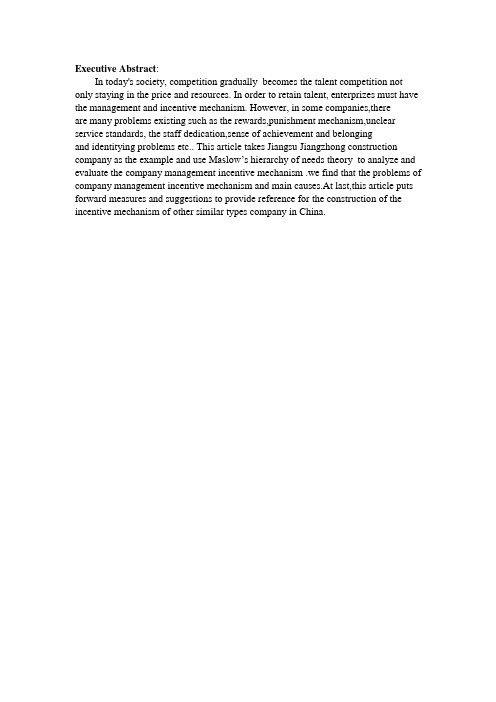
Executive Abstract:In today's society, competition gradually becomes the talent competition not only staying in the price and resources. In order to retain talent, enterprizes must have the management and incentive mechanism. However, in some companies,thereare many problems existing such as the rewards,punishment mechanism,unclear service standards, the staff dedication,sense of achievement and belongingand identitying problems etc.. This article takes Jiangsu Jiangzhong construction company as the example and use Maslow’s hierarchy of needs theory to analyze and evaluate the company management incentive mechanism .we find that the problems of company management incentive mechanism and main causes.At last,this article puts forward measures and suggestions to provide reference for the construction of the incentive mechanism of other similar types company in China.Directory1 Introduction (1)1.1Maslow's hierarchy of needs theory (1)1.2 reasons for selection of Maslow's hierarchy of needs theory (1)2 Taking Jiangsu Jiangzhong group as an example (1)2.1 The basic situation of the company (1)2.2 Problems (2)2.2.1 management concepts backward (2)2.2.2 Management is not based on evaluation mechanism (2)2.2.3Employee training system is not perfect (2)2.3Application of Maslow's hierarchy needs theory (3)Measures to meet Physiological needs and Safety needs (3)Measures to meet Love and belonging needs and Esteem needs (3)Measures to meet Self-actualization (3)3 Recommendations (4)4 Reference (4)1 IntroductionMaslow's hierarchy of needs theoryMaslow's hierarchy of needs theory is also called the "hierarchy theory of needs", put forward by psychologist Maslow. Maslow's theory of the demandis divided into Physiological needs, Safety needs, Love and belonging needs, Esteem needs and Self-actualization, followed by a lower level to a higher level, as shown in figure 1.Figure 11.2 reasons for selection of Maslow's hierarchy of needs theoryThis article Choses Maslow's hierarchy of needs theory because Maslow's hierarchy of needs theory reflects the common law of human behavior and mental activities in a certain extent. Maslow seized the key issue from the people's needs and motivation to explore and studying the behavior of people; Maslow pointed out that human needs are constantly developing from lower level to higher level and this trend is basically accord with law of development needs. Most people’s need structures are very complex and there are many needs affectin our behaviors. In general, higher level needs have sufficient vitality driving behavior only the lower levels be met.The waya to meet the needs of higher level are more than the ways to satisfy the lower level requirements.2 Taking Jiangsu Jiangzhong group as an example2.1 The basic situation of the companyJiangsu Jiangzhong group is a construction unit developing from a small workshop and has a national class enterprise qualification, ownning 10 construction companies.The organizational structure of the company is the chairman responsibility system and the branch general manager responsibility system. The general manager is responsible for operating subsidiaries and submits annual profit 30%management fee to the headquarters.The last funds are for the subsequent development of the company. Its management mode in the similar enterprises is typical. The company hasmore than 10000 employees, so it has rich human resources and it is easy for us to find the problems. The Jiangsu Jiangzhong has its own spirit ofenterprise, "pragmatic, pioneering and innovative", concept "talent is thecore, quality is the center, the development of life", tenet "honesty, customerfirst,casting construction in high quality".2.2 ProblemsJiangsu Jiangzhong group develops in a high speed since its inception. It experienced the most brilliant construction history of China for ten years. In this ten years, Jiangsu Jiangzhong group accumulated abundant capital and a wealth of management experience.Although all aspects of Jiangsu Jiangzhong group develops well, there are some common problems in the management.2.2.1 management concepts backwardJiangsu Jiangzhong group’s project managers generally develop from the bottom of the staff.With no management knowledge background, their culture level is not high. Some managers think that staff motivation is a regular job, which does not spend too much energy. The result is that a lot of talent frequently change jobs.As we can see in the company, the main managemengt disease is the common family management. Many positions are made by the chairman of the board or the project manager. Management personnel are almost all the relatives and the seniority is serious. Jiangsu Jiangzhong group do not establish the incentive mechanism of talent from the management idea and do not remove the family managementproblems which will restrict the further development of enterprise. Management idea backwardness is the disadvantage which restricts the development of the company. 2.2.2 Management is not based on evaluation mechanismAlthough the enterprise has experienced 10 years of development, the company management system is not mature.The company did not set the working standard and it was difficult for the company to carry out the performance evaluation reasonable for the employees. We know that the lack of evidence for evaluation, incentive is the passive water. Motivating subordinates should be based on the performance assessment. Assessment should be carried under the strict regulations, not according to the managers. Company did not create a good atmosphere of fair, objective.It was difficult to satisfy the employee's basic needs and desires.The turnover rate is high and the employees will become less active, so they worked not with their all lengths. Employee training system is not perfectStaff training is a benefit for all employees, which is refers to the training and quality training of staff. Every motivated employees want to improve themselves through this training.Jiangsu Jiangzhong group has no in-depth training, only training project manager and other senior executives.There are no training for technicians and other low-level employees.The most number of employees’attitudes and behavior will change because they do not update their knowledge,develop skills and change in the work.The staff can not qualify for work or for higher positions.The company can not meet the demand of staff to learn new knowledge,so employees in the company can not see the hope and progress in the future, so they will naturally losetheir enthusiasm and their loyalty to the company.Application of Maslow’s hierarchy needs theoryIt is important for the enterprises which want to develop in a healthy way tobe good at learning new knowledge and correct shortcomings. According tothe analysis of Jiangsu Jiangzhong, we put forward the following methods to sollut the group's questions with hierarchy needs theory application of Maslow, Measures to meet Physiological needs and Safety needsThe physiological needs and safety needs of employees is the basic needs and other demands are based on them.The physiological needs and safety needs are relatively simple and this kind of demand can meet as long as the enterprise do the most basic things. For example: providing health insurance or commercial insurance, providing good accommodation, unemployment insurance; formulating relevant policies, protecting the legitimate rights and interests of employees, taking additional measures to ensure that employees can not be affected by theexternal violence;hiring security guards, regular inspection; hiring aprofessional chef, providing delicious food for the staff; treating every employee in the same way,making every employee feel without discrimination.In the company's internal management, the manager must arrange different plans according to different needsto maximize the benefits of human resources.Measures to meet Love and belonging needs and Esteem needsOn the one hand, establishing the training system can satisfy the employees’thirst for knowledge and can improve the staff's working abilities. Throughtraining, employees feel that the company may pay attention on them.They will be in full of longing for the future.For example, allowing the project manager toread MBA, allowing technicians to go to school to take part in training to obtain the corresponding qualification certificates.On the other hand, the enterprise should establish performanceevaluation system.The performance system is a feedback system dependingon objectives or performance standards, using the evaluation methods, to evaluate staff's completion of tasks, to ensure responsibilities to fulfill the degree of development.This system let employees feel that if they want to be successful they should do their best. To help employees talent showing itself the system should respect the opinions of the staff,.Measures to meet Self-actualizationA lot talent stop their steps because of the poor management idea and the management of family barriers.Stuff who has the highest needs is thevaluable property of enterprises. The solution: on the one hand, showingthe importance of talent, providing opportunities to take charge as chief of a project can help employees achieve its ultimate goal, so employees can work for the company; on the other hand, according to the actual situation, establishing incentive mechanism and making the outstanding employees clear the work objectives can mobilize the enthusiasm and promote the development of enterprises.It is importantto help employees to realize the value of life. Only meeting the needs of employees’self-realization, these talents will continue to maintain a strong fighting spirits and continue to work for the company.3 RecommendationsMaslow's hierarchy of needs theory is the most extensive theory in researching the excitation organizations. As we know that every employee has own long-term and short-term goal.Everyone may try to meet certain requirements.There will be a new need to replace finished one,so the process is long and step by step. Thus, the incentive mechanism established by the company should be effective and flexible.The system should differentiate the employees. Application of the Maslowhierarchy needs theory can help the company achieve the maximum benefit and stasify employees’ long-term needs4 Reference[1] Pan Lianbai, Wu Na. "Principle" of management science, 2013[2] ChenFuxi. Using Maslow's hierarchy of needs theory in enterprise management.Management science "and" small and medium enterprises, 2002[3] Guo Ming. Maslow's "hierarchy of needs theory" analysis. "Journal of Shangqiu Normal University, 2007[4]Hua snow. Using Maslow's hierarchy of needs theory in the library."Chinese western science", 2013[5]garden. Maslow theory on organizational loyalty. Based on the "Oriental Enterprise Culture", 2013。
- 1、下载文档前请自行甄别文档内容的完整性,平台不提供额外的编辑、内容补充、找答案等附加服务。
- 2、"仅部分预览"的文档,不可在线预览部分如存在完整性等问题,可反馈申请退款(可完整预览的文档不适用该条件!)。
- 3、如文档侵犯您的权益,请联系客服反馈,我们会尽快为您处理(人工客服工作时间:9:00-18:30)。
执行摘要:现在社会中,竞争不再只停留在价格、资源上,而是逐渐演变人才的竞争。
要想留住优秀的人才,必须要有成熟的公司管理和激励机制。
然而,在一些公司之中,管理上往往存在诸多不足,比如奖惩机制服务标准不明确、员工事业心和成就感不足、归属感和认同感不足等。
本文以江苏江中建筑公司为例,运用马斯洛层次需要理论对公司管理激励机制进行了分析评价,发现存在的问题以及问题产生的主要原因,提出完善公司管理激励机制的对策和建议,为我国其他相似类型的公司的激励机制建设提供借鉴经验。
目录1背景介绍 (1)1.1马斯洛需求层次理论 (1)1.2选取马斯洛需求层次理论的原因 (1)2.以江苏江中集团为例进行分析 (1)2.1公司基本情况 (1)2.2出现的问题 (2)2.2.1管理观念落后 (2)2.2.2管理与考核机制脱节 (2)2.2.3没有健全的员工培训体系 (2)2.3应用马斯洛层次需求理论探讨解决办法 (3)2.3.1满足员工生理需求、安全需求的激励措施 (3)2.3.2满足员工社会交往需求、尊重需求的激励措施 (3)2.3.3满足员工自我实现需求的激励措施 (3)3.总结建议 (4)4.参考文献 (4)1背景介绍1.1马斯洛需求层次理论马斯洛需求层次理论又称"基本需求层次理论",是由心理学家马斯洛提出。
马斯洛理论把需求分成生理需求、安全需求、归属与爱的需求、尊重需求和自选取马斯洛需求层次理论的原因之所以选择马斯洛层次需要理论,是因为马斯洛需求层次理论在一定程度上反映了人类行为和心理活动的共同规律。
马斯洛从人的需要出发探索人的激励和研究人的行为,抓住了问题的关键;马斯洛指出了人的需要是由低级向高级不断发展的,这一趋势基本上符合需要发展规律的。
大多数人的需要结构很复杂,无论何时都有许多需求影响着我们的行为。
一般来说,只有在较低层次的需求得到满足之后,较高层次的需求才会有足够的活力驱动行为。
满足较高层次需求的途径多于满足较低层次需求的途径。
2.以江苏江中集团为例进行分析2.1公司基本情况江苏江中集团是从一个小作坊,一步一步发展到具有国家特级企业资质的建筑施工单位,下辖了10个土建公司和其他一些全资子工资。
公司的组织结构实行董事长负责制,分公司总经理负责制。
总经理全权负责子公司的运营情况,每年定期向总部交利润30%管理费,其他资金用于公司的后续发展,其管理模式在中国同类企业中比较典型。
公司的员工10000余人,人力资源丰富,方便发现其中问题。
江苏江中有自己的企业精神,是“求真务实,开拓创新”,理念是坚持以“人才是核心,质量是中心,发展是生命”的,经营宗旨是“诚信为本,用户至上,铸建筑精品,竖时代丰碑”。
2.2出现的问题江苏江中集团自从成立以来,发展十分迅速。
它经历了中国历史上建筑业最辉煌的十年。
在这十年里,江苏江中集团在积累雄厚的资金的同时,也积累了丰富的管理经验。
尽管江苏江中集团各个方面做得很好,但是也难以逃离企业管理中的一些通病。
2.2.1管理观念落后江苏江中集团的项目经理,一般都是从最底层的员工做起的,没有管理知识的背景,文化程度普遍不高。
有些经理认为,员工激励是一件常规性的工作,无须花太多的精力。
其结果呢,直到发现很多人才频繁跳槽,才真正认识到员工激励方面的失败。
在公司内部,难逃家族管理的通病。
很多要职,都是由董事长或者项目经理亲自制定。
管理人员几乎都是亲戚,排资论辈现象严重。
江苏江中集团没有从管理观念上建立对于人才的激励机制,没有去除掉限制企业进一步发展的家族管理问题。
管理观念的落后是制约公司发展的瓶颈。
2.2.2管理与考核机制脱节尽管经历了十多年的发展,公司内部企业管理制度并不是很健全。
很多时候,没有设定工作标准,难以对员工进行合理的业绩考核。
我们知道缺乏考核依据,激励便是无源之水。
激励下属应当有依据,这个依据就是对工作业绩的考核。
考核要按照规章制度严格进行,不是经理说做得好就是好。
公司内部没有营造好公平、公正、客观的氛围。
满足不了员工的基本需求和愿望,离职率自然就会高,员工的积极程度就会降低,自然就不会在工作中全力以赴。
2.2.3没有健全的员工培训体系员工培训对于员工来说,是一项福利,是指员工技能培训和员工素质培训。
每一个有上进心的员工都想通过培训,提升自己。
江苏江中集团没有深入地进行员工培训,只是培训项目经理等一些高管,技术员等底层员工的培训少。
没有使绝大多少数员工不断的更新知识,开拓技能,进而没有改变员工的工作动机、态度和行为,没有使员工更好的胜任现职工作或担负更高级别的职务。
满足不了员工学习新知识的需求,员工在公司内部发展看不到希望,看不到进步的空间,自然就会失去积极性,失去对公司的忠诚度。
2.3应用马斯洛层次需求理论探讨解决办法企业要想发展好,必须善于学习新知识,改正存在缺点。
针对对江苏江中集团分析后提出的问题,应用马斯洛层次需求理论,提出以下改革方法。
2.3.1满足员工生理需求、安全需求的激励措施生理需求和交往需求是员工最基本的需求,任何需求都是在这个基础上产生的。
实现员工的生理需求和安全需求较为简单,只要做好最基本的事情,这类需求均能满足。
比如:提供医疗保险或者商业保险,提供良好的住宿,失业保险;制定相关安全政策,保护员工的合法权益,采取额外措施,使员工不受外界暴力伤害;雇佣保安人员,定期做好防火检查;聘请专业厨师,为员工提供可口的饭菜;平等如一对待每一位员工,让每一个员工都觉得自己不受歧视。
所以,在公司内部,一定要针对不同的人需求作出不同的管理安排,在此基础上,实现人力资源效益的最大化。
2.3.2满足员工社会交往需求、尊重需求的激励措施一方面,建立人才培训制度。
可以满足员工对于知识的渴望,可以提升员工的实际工作能力。
通过培训,员工觉得自己得到了公司的重视,对未来充满向往,进而满足了员工社会交往需求、尊重需求。
比如可以让项目经理去读MBA,可以让技术员去学校培训,考取相应资格证书。
另一方面,建立绩效考评制度。
绩效考评制度是对照工作目标或绩效标准,采用一定的考评方法,评定员工的工作任务完成情况、员工的工作职责履行程度和员工的发展情况,并将上述评定结果反馈给员工的一种制度。
让员工觉得,付出才有成就,努力就会成功。
绩效考聘制度要尊重员工的意见,帮助员工脱颖而出。
2.3.3满足员工自我实现需求的激励措施管理观念落后和家族管理的壁垒,让很多优秀的人才望而却步。
有这种需求的员工,一般层次是最高的,是企业的宝贵财产。
解决的方法是:一方面,要表现出对人才的重视程度,在尊重的基础上提供员工独当一面的机会,帮助员工实现其最终目标,这样员工才能留在公司继续发展;另一方面,根据实际情况建立起激励机制,要让员工明确工作目标,并且清楚实现目标后能得到什么回报,这才能调动大家积极性,促进企业的发展,进一步帮助员工超越自我,实现人生价值。
只有满足了员工自我实现的需求,这些优秀的人才才会继续保持旺盛的斗志,才会继续为公司效力。
3.总结建议马斯洛的需求层次理论是研究组织激励时应用得最广泛的理论。
我们知道,每一位员工都有自己的长期目标和短期目标,都在力图满足某种需求,一旦一种需求得到满足,就会有另一种需要取而代之。
所以这个过程是长期的,循序渐进的。
以此看来,公司制定的激励机制,一定要有针对性和灵活性,对员工进行区别化管理。
应用马斯洛层次需求理论,探明员工的现在需求和长远需求,在管理好员工的同时,实现公司的最大效益和长远发展。
4.参考文献[1]潘连柏、伍娜.《管理学原理》,2013.[2]陈福稀. 马斯洛层次理论在企业管理中的运用.《中小企业管理与科学》,2002.[3]郭明. 马斯洛“需要层次理论”评析.《商丘师范学院学报》,2007.[4]华雪. 马斯洛层次需求理论在图书管理中的运用.《中国西部科学》,2013.[5]田园. 基于马斯洛层次理论试论企业员工组织忠诚度.《东方企业文化》,2013.Executive Abstract:In today's society, competition gradually becomes the talent competition not only staying in the price and resources. In order to retain talent, enterprizes must have the management and incentive mechanism. However, in some companies,there are many problems existing such as the rewards,punishment mechanism,unclear service standards, the staff dedication,sense of achievement and belonging and identitying problems etc.. This article takes Jiangsu Jiangzhong construction company as the example and use Maslow’s hierarchy of needs theory to analyze and evaluate the company management incentive mechanism .we find that the problems of company management incentive mechanism and main causes.At last,this article puts forward measures and suggestions to provide reference for the construction of the incentive mechanism of other similar types company in China.Directory1 Introduction (1)1.1Maslow's hierarchy of needs theory (1)1.2 reasons for selection of Maslow's hierarchy of needs theory (1)2 Taking Jiangsu Jiangzhong group as an example (1)2.1 The basic situation of the company (1)2.2 Problems (2)2.2.1 management concepts backward (2)2.2.2 Management is not based on evaluation mechanism (2)2.2.3Employee training system is not perfect (2)2.3Application of Maslow's hierarchy needs theory (3)2.3.1Measures to meet Physiological needs and Safety needs (3)2.3.2Measures to meet Love and belonging needs and Esteem needs (3)2.3.3Measures to meet Self-actualization (3)3 Recommendations (4)4 Reference (4)1 Introduction1.1Maslow's hierarchy of needs theoryMaslow's hierarchy of needs theory is also called the "hierarchy theory of needs", put forward by psychologist Maslow. Maslow's theory of the demand is divided into Physiological needs, Safety needs, Love and belonging needs, Esteem needs and Self-actualization, followed by a lower level to a higher level, as shown in figure 1.Figure 11.2 reasons for selection of Maslow's hierarchy of needs theoryThis article Choses Maslow's hierarchy of needs theory because Maslow's hierarchy of needs theory reflects the common law of human behavior and mental activities in a certain extent. Maslow seized the key issue from the people's needs and motivation to explore and studying the behavior of people; Maslow pointed out that human needs are constantly developing from lower level to higher level and this trend is basically accord with law of development needs. Most people’s need structures are very complex and there are many needs affectin our behaviors. In general, higher level needs have sufficient vitality driving behavior only the lower levels be met.The waya to meet the needs of higher level are more than the ways to satisfy the lower level requirements.2 Taking Jiangsu Jiangzhong group as an example2.1 The basic situation of the companyJiangsu Jiangzhong group is a construction unit developing from a small workshop and has a national class enterprise qualification, ownning 10 construction companies.The organizational structure of the company is the chairman responsibility system and the branch general manager responsibility system. The general manager is responsible for operating subsidiaries and submits annual profit 30%management fee to the headquarters.The last funds are for the subsequent development of the company. Its management mode in the similar enterprises is typical. The company has。
